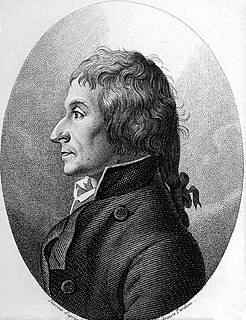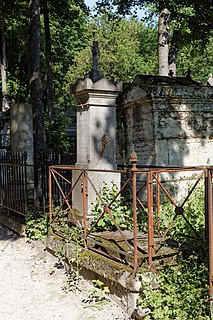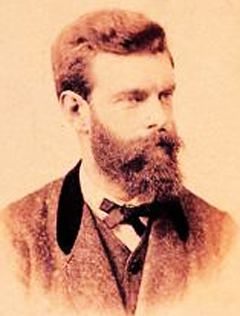


Philippe Buache (born La Neuville-au-Pont, 7 February 1700; died Paris, 24 January 1773) was a French geographer, known for inventing a new system of geography and popularizing this field. [1]



Philippe Buache (born La Neuville-au-Pont, 7 February 1700; died Paris, 24 January 1773) was a French geographer, known for inventing a new system of geography and popularizing this field. [1]
Buache was trained under the geographer Guillaume Delisle, whose daughter he married, and whom he succeeded in the Académie des sciences in 1730. [1]
Buache was nominated first geographer of the king in 1729. He established the division of the world by seas and river systems. He believed in a southern continent, an hypothesis which was confirmed by later discoveries. In 1754, he published an "Atlas physique." He also wrote several pamphlets.
His nephew, Jean Nicolas Buache (born La Neuville-au-Pont, 15 February 1741; died Paris, 21 November 1825), was also a geographer of the king.

Joseph Louis Proust was a French chemist. He was best known for his discovery of the law of definite proportions in 1794, stating that chemical compounds always combine in constant proportions.

René Primevère Lesson was a French surgeon, naturalist, ornithologist, and herpetologist.

Alphonse Milne-Edwards was a French mammalologist, ornithologist, and carcinologist. He was English in origin, the son of Henri Milne-Edwards and grandson of Bryan Edwards, a Jamaican planter who settled at Bruges.

Ferdinand Berthoud, was a scientist and watchmaker. He became master watchmaker in Paris in 1753. Berthoud, who held the position of Horologist-Mechanic by appointment to the King and the Navy, left behind him an exceptionally broad body of work, in particular in the field of sea chronometers.

Édouard Louis Trouessart was a French zoologist born in Angers.

Jean-Baptiste Geneviève Marcellin Bory de Saint-Vincent was a French naturalist, officer and politician. He was born on 6 July 1778 in Agen (Lot-et-Garonne) and died on 22 December 1846 in Paris. Biologist and geographer, he was particularly interested in volcanology, systematics and botany. The standard author abbreviation Bory is used to indicate this person as the author when citing a botanical name.

Nicolas Sanson was a French cartographer who served under two kings in matters of geography. He has been called the "father of French cartography."
Émile-Félix Gautier or Gauthier was a French geographer.
Philippe Victor Diolé was a French author and undersea explorer.
Charles Henri Marie Flahault was a French botanist, among the early pioneers of phytogeography, phytosociology, and forest ecology. The word relevé for a plant community sample is his invention.

Charles Pierre Claret, comte de Fleurieu was a French Navy officer, explorer, hydrographer and politician. He served as Minister of the Navy under Louis XVI, and was a member of the Institut de France. He was brother to botanist Marc Antoine Louis Claret de La Tourrette.

Charles-Marie Philippe de Kerhallet was a French navigator. He received his education in the naval school of Angoulême, became a midshipman in 1825, and was promoted captain in 1849. He served in South America, commanded the stations of Newfoundland and Cayenne, made soundings in the Gulf of Mexico, and prepared valuable charts. His works include Instructions pour remonter la côte du Brésil depuis San Luiz de Maranhão jusqu'au Para ; Description nautique de la côte du Mexique (1849); Description nautique de la côte de l'isthme de Panama (1850); Considérations générales sur l'Océan Atlantique (1852); Considérations générales sur l'Ocean Pacifique (1853); and La navigation dans la mer des Antilles et le golfe du Mexique (1859).
The history of French cartography can be traced to developments in the Middle Ages. This period was marked by improvements in measuring instruments and also by an upgrade of work in registers of all types. What is thought to be the oldest land map in Europe, the Saint-Bélec slab, representing an area the Odet valley, was found in 1900, and rediscovered in a cellar in a castle in France in 2014. The Bronze-Age stone is thought to be 4,000-years old.
Jean-Baptiste Benoît Eyriès was a French geographer, author and translator, best remembered in the English speaking world for his translation of German ghost stories Fantasmagoriana, published anonymously in 1812, which inspired Mary Shelley and John William Polidori to write Frankenstein and The Vampyre respectively. He was one of the founding members of the Société de Géographie, a member of the Société Asiatique, Académie des Inscriptions et Belles-Lettres, American Philosophical Society, and American Academy of Arts and Sciences, was awarded the Legion of Honour, and has a street named after him in Le Havre and a mountain near Humboldt Bay in California.

François Élie Roudaire was a French author, military officer and geographer. He, along with Ferdinand de Lesseps, was a proponent of creating an inland Sahara Sea by flooding areas of the Sahara Desert which were below sea level.

Jean Daniel François Schrader, better known as Franz Schrader, was a French mountaineer, geographer, cartographer and landscape painter, born in Bordeaux. He made an important contribution to the mapping of the Pyrenees and was highly considered among the pyreneists.
Nicolas-Luton Durival was an 18th-century Lorrain civil servant, historian and geographer who became French after 1766.

Louis Vivien, called Vivien de Saint-Martin, was a 19th-century French geographer.

Thomas William Marshall was an English post-impressionist painter and water colorist, born on October 28, 1875 at Donisthorpe in England. He died on September 2, 1914 in Paris.
| Wikimedia Commons has media related to Philippe Buache . |